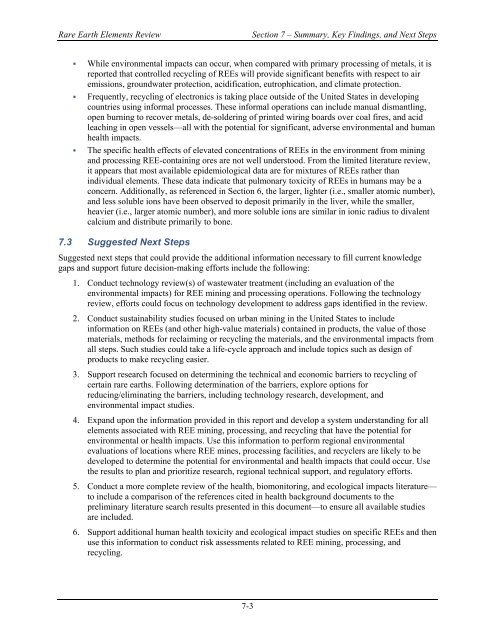Rare Earth Elements: A Review of Production, Processing ...
Rare Earth Elements: A Review of Production, Processing ...
Rare Earth Elements: A Review of Production, Processing ...
Create successful ePaper yourself
Turn your PDF publications into a flip-book with our unique Google optimized e-Paper software.
<strong>Rare</strong> <strong>Earth</strong> <strong>Elements</strong> <strong>Review</strong> Section 7 – Summary, Key Findings, and Next Steps<br />
� While environmental impacts can occur, when compared with primary processing <strong>of</strong> metals, it is<br />
reported that controlled recycling <strong>of</strong> REEs will provide significant benefits with respect to air<br />
emissions, groundwater protection, acidification, eutrophication, and climate protection.<br />
� Frequently, recycling <strong>of</strong> electronics is taking place outside <strong>of</strong> the United States in developing<br />
countries using informal processes. These informal operations can include manual dismantling,<br />
open burning to recover metals, de-soldering <strong>of</strong> printed wiring boards over coal fires, and acid<br />
leaching in open vessels—all with the potential for significant, adverse environmental and human<br />
health impacts.<br />
� The specific health effects <strong>of</strong> elevated concentrations <strong>of</strong> REEs in the environment from mining<br />
and processing REE-containing ores are not well understood. From the limited literature review,<br />
it appears that most available epidemiological data are for mixtures <strong>of</strong> REEs rather than<br />
individual elements. These data indicate that pulmonary toxicity <strong>of</strong> REEs in humans may be a<br />
concern. Additionally, as referenced in Section 6, the larger, lighter (i.e., smaller atomic number),<br />
and less soluble ions have been observed to deposit primarily in the liver, while the smaller,<br />
heavier (i.e., larger atomic number), and more soluble ions are similar in ionic radius to divalent<br />
calcium and distribute primarily to bone.<br />
7.3 Suggested Next Steps<br />
Suggested next steps that could provide the additional information necessary to fill current knowledge<br />
gaps and support future decision-making efforts include the following:<br />
1. Conduct technology review(s) <strong>of</strong> wastewater treatment (including an evaluation <strong>of</strong> the<br />
environmental impacts) for REE mining and processing operations. Following the technology<br />
review, efforts could focus on technology development to address gaps identified in the review.<br />
2. Conduct sustainability studies focused on urban mining in the United States to include<br />
information on REEs (and other high-value materials) contained in products, the value <strong>of</strong> those<br />
materials, methods for reclaiming or recycling the materials, and the environmental impacts from<br />
all steps. Such studies could take a life-cycle approach and include topics such as design <strong>of</strong><br />
products to make recycling easier.<br />
3. Support research focused on determining the technical and economic barriers to recycling <strong>of</strong><br />
certain rare earths. Following determination <strong>of</strong> the barriers, explore options for<br />
reducing/eliminating the barriers, including technology research, development, and<br />
environmental impact studies.<br />
4. Expand upon the information provided in this report and develop a system understanding for all<br />
elements associated with REE mining, processing, and recycling that have the potential for<br />
environmental or health impacts. Use this information to perform regional environmental<br />
evaluations <strong>of</strong> locations where REE mines, processing facilities, and recyclers are likely to be<br />
developed to determine the potential for environmental and health impacts that could occur. Use<br />
the results to plan and prioritize research, regional technical support, and regulatory efforts.<br />
5. Conduct a more complete review <strong>of</strong> the health, biomonitoring, and ecological impacts literature—<br />
to include a comparison <strong>of</strong> the references cited in health background documents to the<br />
preliminary literature search results presented in this document—to ensure all available studies<br />
are included.<br />
6. Support additional human health toxicity and ecological impact studies on specific REEs and then<br />
use this information to conduct risk assessments related to REE mining, processing, and<br />
recycling.<br />
7-3















